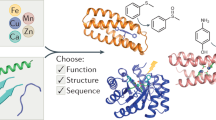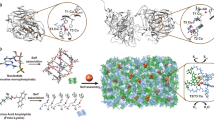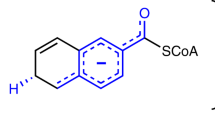Abstract
Enzymes use binding energy to stabilize their substrates in high-energy states that are otherwise inaccessible at ambient temperature. Here we show that a de novo designed Zn(II) metalloprotein stabilizes a chemically reactive organic radical that is otherwise unstable in aqueous media. The protein binds tightly to and stabilizes the radical semiquinone form of 3,5-di-tert-butylcatechol. Solution NMR spectroscopy in conjunction with molecular dynamics simulations show that the substrate binds in the active site pocket where it is stabilized by metal–ligand interactions as well as by burial of its hydrophobic groups. Spectrochemical redox titrations show that the protein stabilized the semiquinone by reducing the electrochemical midpoint potential for its formation via the one-electron oxidation of the catechol by approximately 400 mV (9 kcal mol−1). Therefore, the inherent chemical properties of the radical were changed drastically by harnessing its binding energy to the metalloprotein. This model sets the basis for designed enzymes with radical cofactors to tackle challenging chemistry.
This is a preview of subscription content, access via your institution
Access options
Subscribe to this journal
Receive 12 print issues and online access
$259.00 per year
only $21.58 per issue
Buy this article
- Purchase on Springer Link
- Instant access to full article PDF
Prices may be subject to local taxes which are calculated during checkout




Similar content being viewed by others
References
DeGrado, W. F., Summa, C. M., Pavone, V., Nastri, F. & Lombardi, A. De novo design and structural characterization of proteins and metalloproteins. Annu. Rev. Biochem. 68, 779–819 (1999).
Dürrenberger, M. & Ward, T. R. Recent achievements in the design and engineering of artificial metalloenzymes. Curr. Opin. Chem. Biol. 19, 99–106 (2014).
Faiella, M., Roy, A., Sommer, D. & Ghirlanda, G. De novo design of functional proteins: toward artificial hydrogenases. Biopolymers 100, 558–571 (2013).
Hill, R. B., Raleigh, D. P., Lombardi, A. & DeGrado, W. F. De novo design of helical bundles as models for understanding protein folding and function. Acc. Chem. Res. 33, 745–754 (2000).
Kaplan, J. & DeGrado, W. F. De novo design of catalytic proteins. Proc. Natl Acad. Sci. USA 101, 11566–11570 (2004).
Kiss, G., Celebi-Olcum, N., Moretti, R., Baker, D. & Houk, K. N. Computational enzyme design. Angew. Chem. Int. Ed. 52, 5700–5725 (2013).
Watkins, D. W., Armstrong, C. T. & Anderson, J. L. R. De novo protein components for oxidoreductase assembly and biological integration. Curr. Opin. Chem. Biol. 19, 90–98 (2014).
Zastrow, M. L. & Pecoraro, V. L. Designing functional metalloproteins: from structural to catalytic metal sites. Coord. Chem. Rev. 257, 2565–2588 (2013).
Koga, N. et al. Principles for designing ideal protein structures. Nature 491, 222–227 (2012).
Lu, Y., Yeung, N., Sieracki, N. & Marshall, N. M. Design of functional metalloproteins. Nature 460, 855–862 (2009).
Petrik, I. D., Liu, J. & Lu, Y. Metalloenzyme design and engineering through strategic modifications of native protein scaffolds. Curr. Opin. Chem. Biol. 19, 67–75 (2014).
Farid, T. A. et al. Elementary tetrahelical protein design for diverse oxidoreductase functions. Nature Chem. Biol. 9, 826–833 (2013).
Lichtenstein, B. R. et al. Engineering oxidoreductases: maquette proteins designed from scratch. Biochem. Soc. Trans. 40, 561–566 (2012).
Bhagi-Damodaran, A., Petrik, I. D., Marshall, N. M., Robinson, H. & Lu, Y. Systematic tuning of heme redox potentials and its effects on O2 reduction rates in a designed oxidase in myoglobin. J. Am. Chem. Soc. 136, 11882–11885 (2014).
Cangelosi, V. M., Deb, A., Penner-Hahn, J. E. & Pecoraro, V. L. A de novo designed metalloenzyme for the hydration of CO2 . Angew. Chem. Int. Ed. 53, 7900–7903 (2014).
Yu, F. et al. Protein design: toward functional metalloenzymes. Chem. Rev. 114, 3495–3578 (2014).
Zastrow, M. L. & Pecoraro, V. L. Designing hydrolytic zinc metalloenzymes. Biochemistry 53, 957–978 (2014).
Song, W. J. & Tezcan, F. A. A designed supramolecular protein assembly with in vivo enzymatic activity. Science 346, 1525–1528 (2014).
Calhoun, J. R. et al. Artificial diiron proteins: from structure to function. Biopolymers 80, 264–278 (2005).
Reig, A. J. et al. Alteration of the oxygen-dependent reactivity of de novo Due Ferri proteins. Nature Chem. 4, 900–906 (2012).
Pearson, A. D. et al. Trapping a transition state in a computationally designed protein bottle. Science 347, 863–867 (2015).
Hay, S., Westerlund, K. & Tommos, C. Moving a phenol hyrdoxyl group from the surface to the interior of a protein: effects on the phenol potential and pKA . Biochemistry 44, 11891–11902 (2005).
Ravichandran, K. R., Liang, L., Stubbe, J. & Tommos, C. Formal reduction potential of 3,5-difluorotyrosine in a structured protein: insight into multistep radical transfer. Biochemistry 52, 8907–8915 (2013).
Tommos, C., Skalicky, J. J., Pilloud, D. L., Wand, A. J. & Dutton, P. L. De novo proteins as models of radical enzymes. Biochemistry 38, 9495–9507 (1999).
Tommos, C., Valentine, K. G., Martínez-Rivera, M. C., Liang, L. & Moorman, V. R. Reversible phenol oxidation and reduction in the structurally well-defined 2-mercaptophenol-α3C protein. Biochemistry 52, 1409–1418 (2013).
Glover, S. D. et al. Photochemical tyrosine oxidation in the structurally well-defined α3Y protein: proton-coupled electron transfer and a long-lived tyrosine radical. J. Am. Chem. Soc. 136, 14039–14051 (2014).
Berry, B. W., Martínez-Rivera, M. C. & Tommos, C. Reversible voltammograms and a Pourbaix diagram for a protein tyrosine radical. Proc. Natl Acad. Sci. USA 109, 9739–9743 (2012).
Dooley, D. M. et al. A Cu(I)-semiquinone state in substrate-reduced amine oxidases. Nature 349, 262–264 (1991).
Kalyanaraman, B., Felix, C. C. & Sealy, R. C. Semiquinone anion radicals of catechol(amine)s, catechol estrogens, and their metal ion complexes. Environ. Health Perspect. 64, 185–198 (1985).
Land, E. J., Ramsden, C. A. & Riley, P. A. Tyrosinase autoactivation and the chemistry of ortho-quinone amines. Acc. Chem. Res. 36, 300–308 (2003).
Mure, M. Tyrosine-derived quinone cofactors. Acc. Chem. Res. 37, 131–139 (2004).
Peover, M. E. & Davies, J. D. The influence of ion-association in the polarography of quinones in dimethylformamide. J. Electroanal. Chem. 6, 46–53 (1963).
Chung, T. D. et al. Electrochemical behavior of calix[4]arenediquinones and their cation binding properties. J. Electroanal. Chem. 396, 431–439 (1995).
Stallings, M. D., Morrison, M. M. & Sawyer, D. T. Redox chemistry of metal–catechol complexes in aprotic media. 1. Electrochemistry of substituted catechols and their oxidation products. Inorg. Chem. 20, 2655–2660 (1981).
Bodini, M. E., Copia, G., Robinson, R. & Sawyer, D. T. Redox chemistry of metal–catechol complexes in aprotic media. 5. 3,5-Di-tert-butylcatecholato and 3,5-di-tert-butylsemiquinonato complexes of zinc(II). Inorg. Chem. 22, 126–129 (1983).
Benelli, C., Dei, A., Gatteschi, D. & Pardi, L. Electronic and CD spectra of catecholate and semiquinonate adducts of zinc(II) and nickel(II) tetraaza macrocyclic complexes. Inorg. Chem. 28, 1476–1480 (1989).
Guin, P. S., Das, S. & Mandal, P. C. Electrochemical reduction of quinones in different media: a review. Int. J. Electrochem. 2011, 1–22 (2011).
Faiella, M. et al. An artificial di-iron oxo-protein with phenol oxidase activity. Nature Chem. Biol. 5, 882–884 (2009).
Jovanovic, S. V., Kónya, K. & Scaiano, J. C. Redox reactions of 3,5-di-tert-butyl-1,2-benzoquinone. Implications for reversal of paper yellowing. Can. J. Chem. 73, 1803–1810 (1995).
Kalyanaraman, B., Premovic, P. I. & Sealy, R. C. Semiquinone anion radicals from addition of amino acids, peptides, and proteins to quinones derived from oxidation of catechols and catecholamines. J. Biol. Chem. 262, 11080–11087 (1987).
Tratnyek, P. G. et al. Visualizing redox chemistry: probing environmental oxidation–reduction reactions with indicator dyes. Chem. Educator 6, 172–179 (2001).
Clore, G. M. & Iwahara, J. Theory, practice, and applications of paramagnetic relaxation enhancement for the characterization of transient low-population states of biological macromolecules and their complexes. Chem. Rev. 109, 4108–4139 (2009).
Otting, G. Protein NMR using paramagnetic ions. Annu. Rev. Biophys. 39, 387–405 (2010).
Dapprich, S., Komáromi, I., Byun, K. S., Morokuma, K. & Frisch, M. J. A new ONIOM implementation in Gaussian 98. 1. The calculation of energies, gradients and vibrational frequencies and electric field derivatives. J. Mol. Struct. (Theochem) 462, 1–21 (1999).
Shiba, T. et al. Structure of the trypanosome cyanide-insensitive alternative oxidase. Proc. Natl Acad. Sci. USA 110, 4580–4585 (2013).
Herbst, R. M. & Shemin, D. Acetylglycine. Org. Synth. Coll. 2, 1 (1943).
Delaglio, F. et al. NMRPipe: a multidimensional spectral processing system based on UNIX pipes. J. Biomol. NMR 3, 277–293 (1995).
SPARKY 3 (University of California, San Francisco).
Dutton, P. L. Redox potentiometry: determination of midpoint potentials of oxidation–reduction components of biological electron-transfer systems. Methods Enzymol. 54, 411–435 (1978).
The PyMOL Molecular Graphics System, Version 1.3r1 (Schrödinger, LLC, 2010).
Acknowledgements
We thank R. Cooke and N. Naber for access to the EPR instrument, and for valuable discussions and advice. We thank M. Bhate for help in the initial NMR data collections, and M. Stenta for useful advice on setting up the molecular modelling. This work was supported in part by grant No. GM54616 and grant No. GM071628 from the National Institutes of Health to W.F.D. We also acknowledge support from the National Science Foundation (NSF) grant CHE 1413295 and the Materials Research Science and Engineering Centers program of the NSF, grant DMR-1120901. T.L. acknowledges support from the Swiss National Foundation of Science Fellowship 148914.
Author information
Authors and Affiliations
Contributions
G.U. and W.F.D. conceived and designed the research. G.U. and W.F.D. wrote the manuscript. G.U. prepared the samples and reagents and performed the research. G.U. and G.T.G. designed and conducted the spectrochemical redox titration experiments. T.L. designed and performed the QM/MM molecular modelling. Y.W. recorded and analysed NMR data. T.L. and Y.W. contributed equally to this work.
Corresponding author
Ethics declarations
Competing interests
The authors declare no competing financial interests.
Supplementary information
Supplementary information
Supplementary information (PDF 11544 kb)
Rights and permissions
About this article
Cite this article
Ulas, G., Lemmin, T., Wu, Y. et al. Designed metalloprotein stabilizes a semiquinone radical. Nature Chem 8, 354–359 (2016). https://doi.org/10.1038/nchem.2453
Received:
Accepted:
Published:
Issue Date:
DOI: https://doi.org/10.1038/nchem.2453
This article is cited by
-
Indole-5,6-quinones display hallmark properties of eumelanin
Nature Chemistry (2023)
-
Enzymatic post-treatment of ozonation: laccase-mediated removal of the by-products of acetaminophen ozonation
Environmental Science and Pollution Research (2023)
-
Bio-inspired lanthanum-ortho-quinone catalysis for aerobic alcohol oxidation: semi-quinone anionic radical as redox ligand
Nature Communications (2022)
-
Synthesis of atomic platinum with high loading on metal-organic sulfide
Science China Materials (2022)
-
Electrochemical evidence for catechol oxidation by ruthenium(II) organometallics of 2’-hydroxychalcones
Monatshefte für Chemie - Chemical Monthly (2021)



